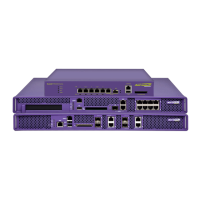Summit WM3000 Series Controller System Reference Guide 153
3 Click the Edit button to display a screen used to modify the WMM parameters. For more
information, see “Editing WMM Settings” on page 155.
4 Select the QoS Mappings button to revise the existing mappings of access category to 802.1p and
DSCP to access category settings.
Access
Displays the Access Category for the intended radio traffic. Access
Categories are the different WLAN-WMM options available.
The four Access Category types are:
•
Background
— Optimized for background traffic
•
Best-effort
— Optimized for best effort traffic
•
Video
— Optimized for video traffic
•
Voice
— Optimized for voice traffic
AIFSN
Displays the current
Arbitrary Inter-frame Space Number
(AIFSN). Higher-
priority traffic categories should have lower AIFSNs than lower-priority
traffic categories. This will causes lower-priority traffic to wait longer
before trying attempting access.
Transmit Ops
Displays the maximum duration a device can transmit after obtaining a
transmit opportunity. For higher-priority traffic categories, this value
should be set to a low number.
ECW Min
The ECW Min is combined with the ECW Max to make the Contention
screen. From this range, a random number is selected for the back off
mechanism. Lower values are used for higher priority traffic.
ECW Max
The ECW Max is combined with the ECW Min to make the Contention
screen. From this range, a random number is selected for the back off
mechanism. Lower values are used for higher priority traffic.
Max Retries
Displays the maximum number of retries for each WMM index.

